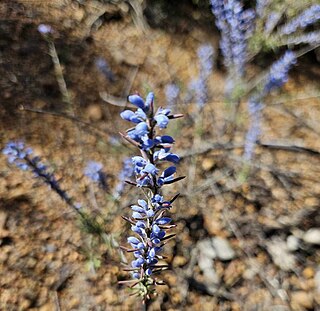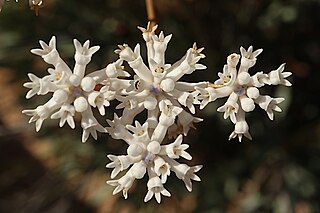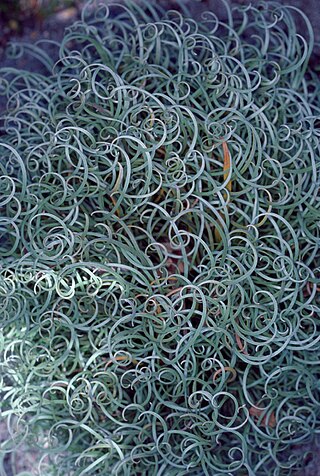
Grevillea diversifolia, the variable-leaved grevillea, is a species of flowering plant in the family Proteaceae and is endemic to the south-west of Western Australia. It is an erect to prostrate shrub with simple or divided leaves and groups white to cream-coloured flowers with a dull red style.

Conospermum longifolium, commonly known as the long leaf smokebush, is a species of flowering plant of the family Proteaceae and is endemic to New South Wales. It is a dense shrub or undershrub with linear to narrowly lance-shaped leaves, panicles of white flowers and velvety, cream-coloured to dark brown nuts.

Conospermum mitchellii, commonly known as Victorian smokebush, is a species of flowering plant of the family Proteaceae and is endemic to the western half of Victoria. It is an erect shrub with crowded, linear leaves, panicles of white, blue or lilac flowers and orange or reddish brown nuts.

Calytrix asperula, commonly known as brush starflower, is a species of flowering plant in the myrtle family Myrtaceae and is endemic to the south of Western Australia. It is a mostly glabrous shrub with linear to narrowly elliptic leaves and cream-coloured to yellow flowers with 40 to 60 yellow stamens in several rows.

Conospermum amoenum, commonly known as blue smokebush, is a species of flowering plant in the family Proteaceae and is endemic to the south-west of Western Australia. It is an erect or spreading shrub with linear leaves, and spikes of blue or white tube-shaped flowers.

Conospermum bracteosum is a species of flowering plant in the family Proteaceae and is endemic to the south-west of Western Australia. It is an erect, spindly shrub with egg-shaped leaves, sometimes with the narrower end towards the base, and spikes of silky, woolly, tube-shaped white flowers.

Conospermum brownii, commonly known as blue-eyed smokebush, is a species of flowering plant in the family Proteaceae and is endemic to the south-west of Western Australia. It is a more or less open shrub with glaucous, lance-shaped leaves with the narrower end towards the base, and spike-like corymbs of white to cream-coloured flowers.

Conospermum canaliculatum is a species of flowering plant in the family Proteaceae, and is endemic to the south-west of Western Australia. It is a dense, multistemmed, erect shrub with linear leaves and spike-like panicles of woolly white, tube-shaped flowers.

Conospermum capitatum is a species of flowering plant in the family Proteaceae, and is endemic to the south-west of Western Australia. It is a low, erect shrub with coiled leaves and head-like panicles of red to pale yellow and hairy, tube-shaped flowers.

Conospermum cinereum is a species of flowering plant in the family Proteaceae and is endemic to the south west of Western Australia. It is a spindly shrub with egg-shaped to lance-shaped leaves, loose spikes of woolly, tube-shaped white flowers and woolly nuts.

Conospermum filifolium is a species of flowering plant in the family Proteaceae and is endemic to the south-west of Western Australia. It is a shrub with thread-like, S-shaped leaves, and spike-like panicles of woolly white, occasionally blue, tube-shaped flowers.

Conospermum leianthum is a species of flowering plant in the family Proteaceae and is endemic to the south-west of Western Australia. It is a shrub with thread-like leaves, and panicles of white and more or less purple, tube-shaped flowers.
Conospermum microflorum is a species of flowering plant of the family Proteaceae and is endemic to Western Australia. It is a rounded shrub with glabrous, thread-like leaves, panicles of woolly hairy, white or cream coloured flowers and woolly hairy, orange-brown nuts.
Conospermum petiolare is a species of flowering plant in the family Proteaceae and is endemic to the south of Western Australia. It is a tufted subshrub or shrub with dense, erect, narrowly oblong leaves, and panicles of velvety cream-coloured, orange-yellow or pink, tube-shaped flowers, the fruit a hairy, brownish-yellow to gold-coloured nut.

Jacksonia lehmannii is a is a species of flowering plant in the family Fabaceae and is endemic to the south-west of Western Australia. It is an erect to prostrate or spreading, spindly shrub with greyish-green branches, sharply-pointed side branches, its leaves reduced to scales leaves, yellowish-orange flowers with orange-red markings, and woody, hairy pods.

Conospermum hookeri, commonly known as Tasmanian smokebush, is a species of flowering plant in the family Proteaceae and is endemic to Tasmania. It is a shrub with many branches, spatula-shaped or linear leaves, panicles of spikes of white, tube-shaped flowers and reddish brown nuts covered with silky fawn-coloured hairs.

Hibbertia hibbertioides is a species of flowering plant in the family Dilleniaceae and is endemic to near-coastal areas of south-western Western Australia. It is a small, prostrate or sprawling shrub with crowded, linear cylindrical leaves and yellow flowers with usually eleven stamens arranged in groups around three carpels.

Pultenaea empetrifolia is a species of flowering plant in the family Fabaceae and is endemic to the south-west of Western Australia. It is a spindly, prostrate or spreading shrub with down-curved, cylindrical, grooved leaves and yellow to orange and red flowers.

Daviesia decurrens, commonly known as prickly bitter-pea, is a species of flowering plant in the family Fabaceae and is endemic to the south-west of Western Australia. It is spreading, erect, or low-lying shrub with scattered, sharply-pointed, narrow triangular phyllodes, and yellowish pink and velvety red flowers.

Daviesia trigonophylla is a species of flowering plant in the family Fabaceae and is endemic to the south of Western Australia. It is an erect, bushy shrub with elliptic or egg-shaped phyllodes that are triangular in cross-section, and orange, dark red and maroon flowers.


















